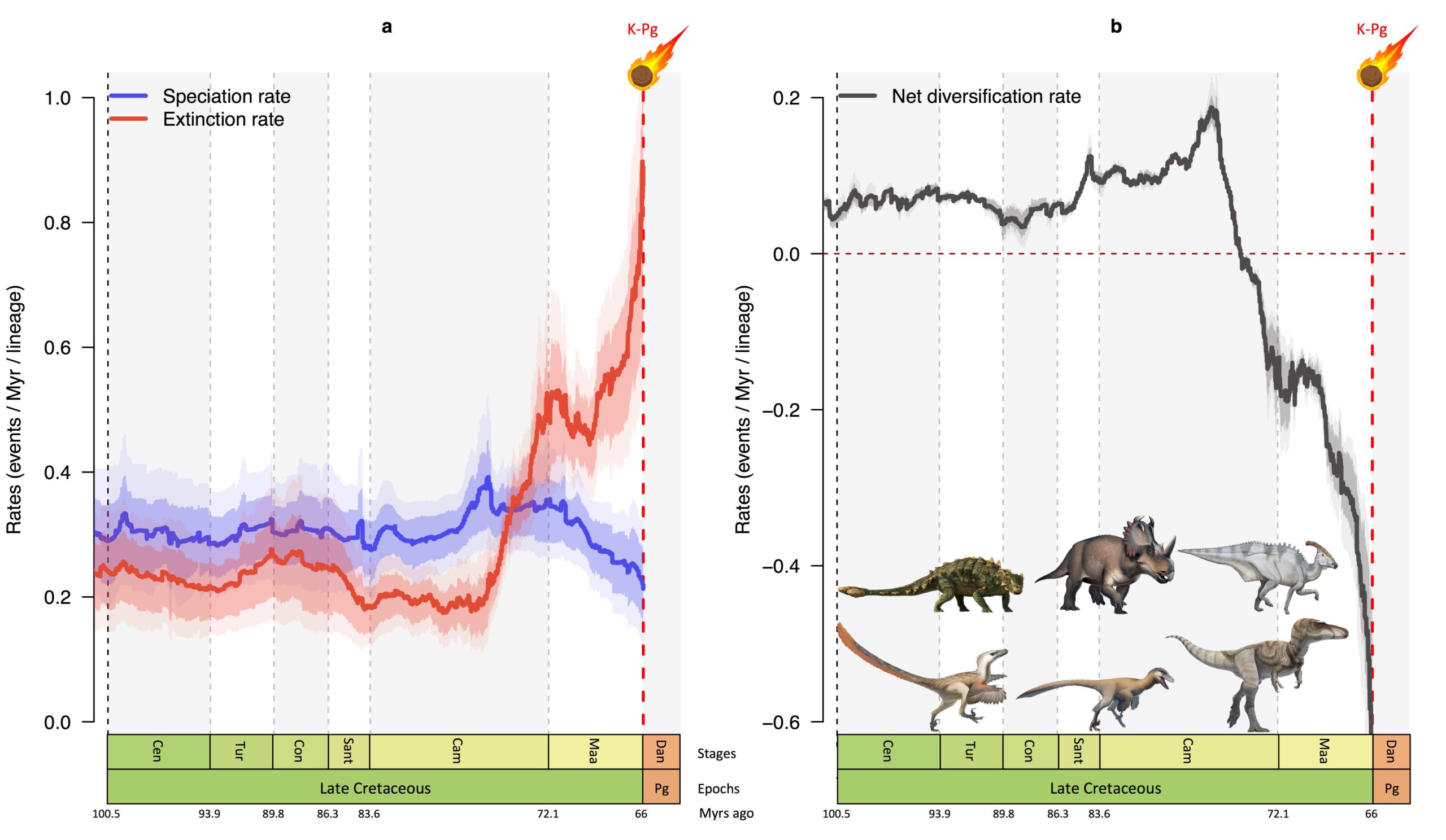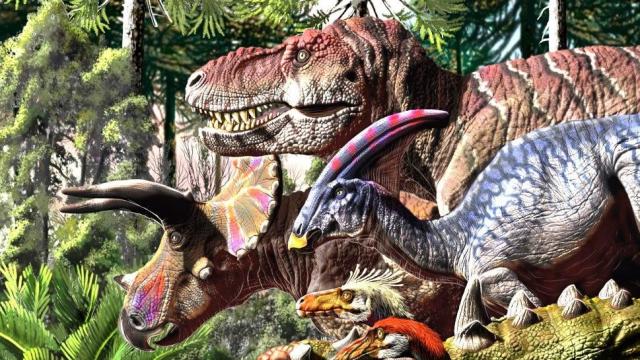A large asteroid wiped out all non-avian dinosaurs 66 million years ago, but these formidable animals were already in decline by that point, in a process that started 10 million years earlier, according to new research. Paleontologists have made similar claims before, but the new study presents a compelling case, while also providing an explanation for the dino downturn.
Dinosaurs dominated the world’s ecosystems until the Late Cretaceous, but as a new paper published in Nature Communications argues, a significant increase in dinosaur extinction rates, combined with an inability to replace lost species, brought dinosaurs to decline long before an approximately 10 km-wide (10-kilometre) asteroid struck the Chicxulub region near what is now Mexico.
“Our results lend support to hypotheses that long-term environmental changes led to restructuring of terrestrial ecosystems that made dinosaurs particularly prone to extinction,” the paleontologists, led by Fabien Condamine from the Institute of Evolutionary Science of Montpellier at the University of Montpellier, wrote in their study.
Indeed, this claim has been made before: that non-avian dinosaurs were hurting and experiencing a gradual waning well before the asteroid, and the asteroid served as a kind of coup de grâce to finish off a process that was already underway. It’s an assertion, however, that’s been tough to prove, given uncertainties having to do with dating of the fossils, selectional effects having to do with the availability of fossils, and deficiencies in evolutionary models, among other concerns. No doubt, it’s hard to grok that non-avian dinosaurs would be withering away after ruling terrestrial environments for 175 million years.
For the new analysis, the team smartly took a comprehensive approach, in which they examined over 1,600 dinosaur fossils, dating to between 150 million and 66 million years ago. They aimed to measure the rate at which dinosaurs were going extinct and the rate at which new species were emerging. Six major and globally distributed dinosaur families were included: Ankylosauridae, Ceratopsidae, Hadrosauridae, Dromaeosauridae, Troodontidae, and Tyrannosauridae.
“I have been collecting dinosaurs in North America, Mongolia, China, and other areas for some time, and I have seen huge improvements in our knowledge of the ages of the dinosaur-bearing rock formations,” Phil Currie, a co-author of the study and a paleontologist at the University of Edmonton, said in a statement. “This means that the data are getting better all the time. The decline in dinosaurs in their last ten million years makes sense, and indeed this is the best-sampled part of their fossil record as our study shows.”

The team applied a statistical modelling technique to the data, which they did to dampen biases and uncertainties. The various models were run millions of times (yes, millions) to weed out errors and — importantly — to identify the most probable patterns. A signal in the data began to appear starting 76 million years ago, indicating the onset of a persistent decline in non-avian dinosaurs. In every case, “we found evidence for the decline prior to the [asteroid] impact,” said Guillaume Guinot, a co-author of the study and a researcher at Montpellier University.
The slump was linked to the extinction of older, well-established species. It seems that dinosaurs struggled to diversify and that evolutionary novelty was increasingly hard to come by. A big part of the problem had to do with the rise of the Hadrosauridae family, a group that included duck-billed dinosaurs; these animals outcompeted other herbivores, resulting in a lack of diversity, according to the new research. Non-avian dinosaurs were also having to contend with a cooling Earth, a process that began about 100 million years ago.
“It became clear that there were two main factors, first that overall climates were becoming cooler, and this made life harder for the dinosaurs which likely relied on warm temperatures,” Mike Benton, a co-author and paleontologist from the University of Bristol’s School of Earth Sciences, said in the press release. “Then, the loss of herbivores made the ecosystems unstable and prone to [an] extinction cascade. We also found that the longer-lived dinosaur species were more liable to extinction, perhaps reflecting that they could not adapt to the new conditions on Earth.”
To which Guinot added: “[It] became clear that the plant-eating species tended to disappear first, and this made the latest dinosaur ecosystems unstable and liable to collapse if environmental conditions became damaging.”
As the scientists conclude in their paper, the eventual extinction of non-avian dinosaurs “cannot be attributed solely” to the asteroid-induced mass extinction, as long-term processes were already underway that “affected the probability” of dinosaur speciation and extinction prior to the Chicxulub impact event. The scientists admit that the six dinosaur families studied, while well represented in the fossil record, don’t give “a complete picture of the global diversification dynamics for all dinosaurs,” but the new study represents a “step forward in our understanding of the causes of dinosaur extinction,” according to the paper. More fossil evidence will be required to clarify and bolster the new analysis.
This study presents a fascinating scenario of decline, and it speaks to an enduring question: What if the asteroid never killed the dinosaurs? We may never know the answer, but as the new study makes clear, things were never going to be the same for the dinosaurs, with or without that fateful asteroid.
